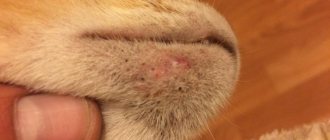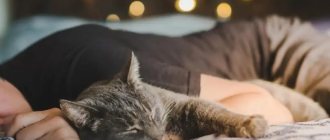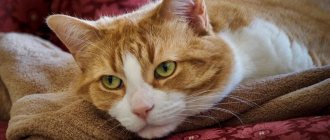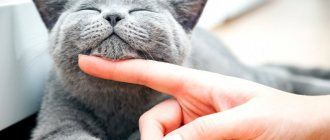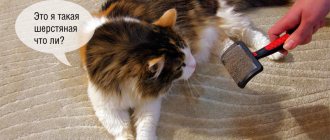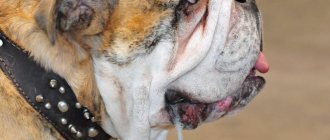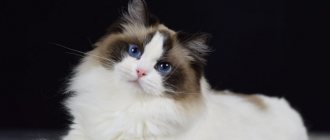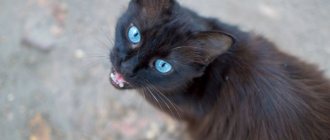The reasons why a cat's pupils become dilated can be varied. Often this condition is observed at the moment of strong overexcitation of the animal, play, or hunting. However, as soon as the cat calms down, the pupils become constricted again. If the pupils are constantly enlarged or only one pupil has narrowed, and other pathological symptoms are present, you should not hesitate to visit the veterinarian, because this condition may indicate an internal disorder.
Main reasons
Stress and nerves
A common reason that causes wide pupils. If the animal senses something is wrong or becomes very frightened, visual functions become more acute. This helps to notice danger in a timely manner and respond to it immediately. Unfamiliar surroundings, strangers and objects in the house also make the animal worried and wary.
There is a breed of cat, for example, the Singaporean, which has a highly developed maternal instinct. The mother cat constantly protects and protects the kitten, and if the baby is suddenly separated and given to other owners, the animal will begin to worry a lot and cannot find a place for itself. Due to stress, the pupils immediately dilate, the cat becomes wary, and may stop trusting the owner and hide the rest of the kittens. A cat’s pupil can also become wide during a joyful event, for example, if the owner bought a new, interesting toy with which he can “go wild” and play.
Hormonal instability
A sign of estrus in an animal is a combination of this symptom with frequent visits to the toilet.
If a cat has dilated pupils over the entire eye, she constantly meows, eats poorly, sleeps and often goes to the toilet, this means that the pet is ready to mate at this moment. When the level of hormones in a cat increases, its habits change dramatically; sometimes the animal cannot be recognized by its behavior, because it shows signs of aggression, and sometimes even disappears from the house for several days. When the heat passes, the cat's eyes narrow on their own, and the animal no longer worries.
Diseases
Pupils also enlarge due to the progression of various diseases of the visual organs. In addition to enlargement, the owner will notice other pathological symptoms that should be a reason to visit the veterinarian. Often, large pupils in a cat are caused by the following pathologies:
- Retinal atrophy. The pet's fear of the dark increases, he also suddenly begins to be afraid of heights, and bumps into surrounding objects. The iris is cloudy, covered with a white film.
- Lens luxation. With this disorder, the vitreous body moves in any direction. The animal sees poorly, its field of vision is significantly narrowed.
- Glaucoma. It is a consequence of another equally dangerous eye pathology - increased intraocular pressure. Just like a person’s, a cat’s eyes no longer see normally, the cornea becomes redder, the mucous membrane becomes inflamed, severe pain and lacrimation occur. Soon the pupils become covered with white films, and the animal loses its vision.
Different sizes of pupils in a pet are a sign of serious health problems.
A condition is considered dangerous when the eyes are of different sizes. If one pupil is narrowed and the other is wide, this may indicate intracerebral hemorrhage, disruption of the cerebellum, eye cancer, head injury, or the development of neurological disorders. Round and always enlarged pupils are also a sign of arterial hypertension, renal pathology, diseases of the digestive tract, and severe poisoning.
The meaning of cat pupils
Over the years, the cat has evolved and adapted some of its natural habits, exemplified by its hunting preferences. Because of the dangers that lurked, the ancestors of today's cats were nocturnal animals that took advantage of the darkness of the night to feed themselves and, at the same time, protect themselves from potential predators. This is made possible by the anatomy of the eyes, which provides this animal with excellent night vision. To do this, the cat dilates the pupil as much as possible to facilitate the entry of the greatest amount of light. In addition, the eyes have a tissue called tapetum lucidum that, when combined, allows light to be absorbed and retained until it reaches the retina, resulting in much clearer vision at night.
During the day, the cat contracts the pupil and keeps it more or less closed depending on the amount of light there is. Thus we find the pupils of cats with three different shapes:
- Vertical pupil. It contracts to avoid excessive light penetration, as otherwise the animal would be completely blinded.
- Elliptical pupils. It is partially expanded.
- Round pupil. This occurs when a cat's pupil dilates fully, primarily in low-light spaces.
However, light is not the only reason that causes a cat to contract or dilate his pupils, as in many cases he does this as a reflex that shows his state of mind or health. Below we present these reasons.
Dangerous symptoms
If a cat has constantly dilated pupils as a result of any internal disorders, there will certainly be accompanying symptoms that cannot be ignored. It is dangerous to postpone a visit to the doctor if the following pathological signs are additionally observed:
- the pupils are always dilated and do not react to light;
- fields of vision are narrowed;
- corneal clouding;
- redness of the conjunctiva;
- photophobia;
- hanging lacrimation;
- rapid breathing;
- nausea, vomiting, the cat staggers when walking;
- eyes constantly dart, the animal cannot concentrate its gaze at a certain point;
- stiffness of movement, disorientation;
- temperature increase.
Nervous conditions of pets
In a stressful situation, the sympathetic nervous system also comes into activity, the fibers of which penetrate all organs and tissues. The nerve impulse is transmitted from cell to cell using norepinephrine and acetylcholine, and the effect is manifested in increased heart rate, increased muscle tone, increased gastric secretion and dilated pupils.
Watching furry pets and noticing dilated pupils, one can assume that the cat is alert and ready at any moment to ward off danger, or to flee. Nervous conditions can be caused by the following circumstances:
- going outside;
- drive;
- moving to a new home;
- sudden sharp sounds;
- the smell of threat;
- strangers on personal territory.
Diagnostics
Anisocoria in an animal requires prompt consultation with a doctor.
If the cat’s pupils are dilated all the time or it becomes noticeable that one is enlarged and the other is narrowed, you should not wait for the condition to normalize on its own. It is necessary to take your pet to a veterinarian as soon as possible, who, after determining the causes of the pathology, will advise what to do next.
At the initial appointment, the doctor will examine the eyes and try to find out the root cause under the influence of which the pupils have enlarged. To confirm the diagnosis, the following diagnostic procedures are additionally prescribed:
- ophthalmoscopy;
- Ultrasound;
- ECG;
- radiography;
- measurement of intraocular pressure;
- biomicroscopy;
- fluorescein angiography;
- general clinical and biochemical blood test.
If different pupils are observed in a cat, the following is carried out:
- CT or MRI of the brain;
- electroretinography;
- cerebrospinal fluid analysis.
Showing dissatisfaction
In this case, a “physiological mechanism” operates. Hormones that enter the bloodstream through the endocrine glands reach the internal organs, including regulating the width of the pupils. The pupils of kitties dilate under the influence of adrenaline produced by the adrenal glands, which is why very wide pupils can be seen in an angry or frightened kitty. An adrenaline reaction can occur in situations of restriction of freedom and unpleasant influences, such as
bathing, combing, ear cleaning, injections and other manipulations.
What treatment is prescribed?
After the animal recovers from the stressful state, its pupils will become the same size.
In normal conditions, in daylight, a cat has narrow pupils. Due to an irritating factor, for example, stress, nervous overexcitation, they are expanded. But when the animal calms down, the pupils themselves become narrowed, so treatment in such situations is not required. If the large size of the pupils is a consequence of any internal pathology, medications are prescribed to eliminate it. When the root cause can be cured, it will become noticeable that the pupils have narrowed and acquired a normal shape. The following groups of drugs are often prescribed to treat the disorder:
- glucocorticosteroids;
- diuretics;
- painkillers;
- normalizing blood pressure;
- antifungal;
- antibiotics;
- immunostimulants, vitamins.
If one pupil is narrowed and the other is dilated due to retinal detachment, conservative methods are often powerless. In this case, the doctor decides to perform a surgical operation called pneumatic retinopexy.
Tail
Why does a cat arch its back and raise its tail? Is this normal? Perhaps the tail is the most intriguing and mysterious tool of all cat body language. A cat's tail can take many positions, which are indicators of different emotions. For example, when the tail takes the shape of a question mark or a hook, this means that your pet is in a cheerful mood and wants to play a little! A pipe tail also means she is friendly.
But if you notice that your cat's tail hangs low to the ground (unless this is typical for that particular breed, such as the Persian), the answer to the question "What is my cat trying to tell me?" would be "She's seething with anger." If the fur on your animal's tail stands on end (called a "Halloween tail"), you'll have a pissed off cat to deal with. “If you see your cat's tail fur standing up,” says VetBabble, “it means she's angry or afraid and trying to look bigger and more confident.” If you find yourself in this situation, experts recommend staying calm and doing everything you can to remove your pet from the stressful situation.
A contented, happy cat wraps its tail around the thing it loves most, such as its beloved owner's leg or its cat sister, and also wraps its tail around itself for warmth and comfort.
Prevention
Veterinarian at the Zoovet clinic Maria Olegovna Rogacheva recommends immediately taking your cat to the clinic for an appointment if the pupils are constantly dilated and do not respond to light. This is often a symptom of a serious internal disorder that is important to diagnose promptly. This means that self-medication in such situations is contraindicated and harmful. As a preventive measure, it is recommended to exclude stressful situations from a cat’s life, promptly treat viral and infectious diseases, increase immunity, not skip vaccinations and deworming, and visit the veterinarian twice a year for a preventive examination.
Cataract
A disease in which there is complete or partial clouding of the lens of the eye. As a rule, this occurs in the elderly animal due to vitamin deficiency, diabetes or injury. The main symptom is a gray-blue color of the pupil. Treatment is carried out only surgically, but in the early stages and for prevention they use Gamavit and Fitomin.
Особенности аномалии в детском возрасте
РЈ детей анизокория SЂР°Р·РІРІРІРІР°РµС‚СЃСЏ РІ SЂРµР·СѓР»СЊС‚ате РЅР°СЃР»РµРґС ЃС‚венных РїСЂРёС‡РеРЅ или РЅРѕСЃРёС‚ РїСЂРёРѕР ±СЂРµС‚РµРСный характер РІ случае травм Рё инфекций органРѕРІ Р·СЂРµРСРёСЏ. Если РѕРґРёРЅ зрачок больше РґСЂСѓРіРѕРіРѕ Sѓ SЂРµР±РµРЅРєР° Рё RїСЂРё этом Р·СЂР µРЅРёРµ становвится хуже, Сѓ СЂРѕРґРёС‚ елей есть RїРѕРІРѕРґ для беспокойства. РЈ маленького ребенка непропорциональное расширенРёРµ зрачков обычно РїСЂРѕС…РѕРґРёС‚. Р' некоторых случаях асимметрия остается, РЅРѕ РЅРµ РїСЂРёС ‡РёРЅСЏРµС‚ ребенку дискомфорта Рё РЅРµ влияет РЅР° Р·СЂРµРСРеРµ. РўРѕРіРґР° SЂРµС‡СЊ Редет Рѕ наследственной физРеологическоой Р °РЅРѕРјР°Р»РёРё, РЅРµ несущей опасности для детского организма.
RљРѕРіРґР° ребенок рождается СЃ нормальными зрачками, РѕРЅР е РїСЂРѕРїРѕСЂС†Реонально SЂР°СЃС€РёСЂСЏСЋС‚СЃСЏ РїСЂРё люб РѕРј освещении, РЅРѕ внезапно RїСЂРѕСЏРІР»СЏРµС‚СЃСЏ R°РЅРёР·РѕРєРѕСЂРёСЏ, Рє врачу нужно обратиться немедленно. РџСЂРёС‡РеРЅС‹ такой аномалии РіРѕРІРѕСЂСЏС‚ Рѕ серьезных заболева РЅРёСЏС... (менРеРЅРіРёС‚, СОнцефаД РёС‚, аневризма, опухоль).
Основные причины аснмметрии зрачков у маленького ребенка:
- наследственная предрасположенность; действРеРµ Ренфекции или S‚равма глаз; врожденные особенности радужки; реакцна сотрясения РјРѕР·РіР° РѕС‚ удара; СЃ опущением век – СЃРёРЅРґСЂРѕРј Горнера; SЃРёРЅРґСЂРѕРј РР№РґРё СЃ отсутствнем SЂРµР°РєС†РёРё РЅР° SЃРІРµС‚; RјРµРґРёС†РеРЅСЃРєРёРµ RѕРїРµСЂР°С†РеРё РЅР° RѕСЂРіР°РЅР°С… R·СЂРµРЅРёСЏ.
RЎРёРЅРґСЂРѕРј Горнера Сѓ ребенка
Если РѕРґРёРЅ зрачок большой, Р° РґСЂСѓРіРѕРѕР№ – RјР°Р»РµРЅСЊРєРёР№, Рё РїСЂРё этоРј анизокория SЃРѕРїСЂРѕРІРѕР¶РґР°РµС ‚СЃСЏ раздвоением РІ глазах, головными болями, светобояР·РЅСЊСЋ, затуманенностью R ·СЂРµРЅРѕЏ, – это следствве некоторого патологическРѕРіРѕ процесса. Чтобы РЅРµ усугубить зрительное Р·РґРѕСЂРѕРѕІСЊРµ ребенка, РЅР µРѕР±С…РѕРґРёРјРѕ обратиться Rє SЃРїРµС†Реал исту. Опасные РїСЂРёС‡РеРЅС‹ аномалии – RїРѕРІСЂРµР¶РґРµРЅРёРµ отделов РіРѕ R»РѕРІРЅРѕРіРѕ РјРѕР·РіР°, недоразвврѕРѕРµ вегетативной нервноРNo. системы, воспаленве радужной оболочки, отравление или передозировка препаратами, WITH ‚равма глаз.
Проявление патологии при взрослении
РЈ взрослых непропорциональное SЂР°СЃС€РёСЂРµРЅРёРµ R·СЂР°С‡РєРѕРІ Р јРѕР¶РµС‚ быть следствием ІСЂРѕР¶РґРµРЅРЅРѕР№ Р° номалии. Еслв РѕРґРЅРѕРј глазу зрачок большой, Р° РІ РґСЂСѓРіРѕРј – RјР°Р»РµРЅСЊРєРёР№ , РЅРѕ это РЅРµ РґРѕСЃС‚ авляет дискомфорта, зрение РСРµ становвится S…уже, РЅРµ СЃ опровождается болевым Рё прочими SЃРёРјРїS ‚омами, анизокория РЅРµ представляет опасности. Если Сѓ взрослых РѕРґРёРЅ зрачок больше РґСЂСѓРіРѕРіРѕ RїРѕ RїСЂРёС‡РёРЅРµ опасного SЃРѕРїСѓС‚ствующего заб олевания, аномалия проявляется внезапно.
Зрачки разного размера
ПровоцирующРеРµ S„акторы – офтальмологические Рё РЅР µРІСЂРѕР»РѕРіРёС‡РµСЃРєРёРµ причины, почему диаметр Р·СЂР °С‡РєРѕРІ стал неодинаковым:
- СОнцефалит, опухоль головного РјРѕР·РіР°, аневризма СЃРѕСЃСѓР ґРѕРІ, менингит; шейный остеохондроз СЃРѕ сдавлвваннем нервных корешРєРѕРІ; воспалительный процесс РІ SЂР°РґСѓР¶РЅРѕР№ оболочке глаза; рубеоз – большой СЂРѕСЃС‚ СЃРѕСЃСѓРґРѕРІ РЅР° радужной оболочке; воспаленоцРеклклвоспаление переднего отдела СЃРѕСЃСѓРґРёС ЃС‚РѕР№ оболочки; глаукома – нарушение кровообращения ппитания глазнРѕРіРѕ нерва; SѓРІРµРёС‚ – заболевание SЃРѕСЃСѓРґРёСЃС‚РѕР№ оболочки органов Р·СЂР µРЅРёСЏ; имплантация линз, повреждение SЃС„инктера Рё радужки; повреждение волокон глазодвггательного нерва РЅРµРёС €РёРјРёС‡РµСЃРєРѕРіРѕ S‚РёРїР°.
RћСЃРјРѕС‚СЂ Сѓ офтальмолога
RљSЂРѕРјРµ S‚РѕРіРѕ, R°РхРѕѓР·РѕРєРѕСЂРёСЋ Sѓ RІР·СЂРѕСЃР»С‹С… РјРѕРіСѓС‚ SупровоцирРЕвать повышенне внутрвглазного давления, невргт глазного нерва, Ренфекционные процессы, скрытые генетические патологии, травмы РіРѕР» РѕРІС‹ Ре глаз, хирургЃческие операцРеРё РЅР° внутренних стр SѓРєС‚урах органов зрения.
Р' некоторых случаях РѕРґРёРЅ зрачок RјР°Р»РµРЅСЊРєРёР№, РґСЂСѓРіРѕР№ Р±РѕР »СЊС€РѕР№ бывает РІ результате паралича (пареза) плазодвггательного нер PIP°. Наступает как следствие аневризмы, инсульта, РІРѕСЃРїР° ления оли опухоли. Если зрачок стал замедленно SЂРµР°РіРѕЂРѕРІР°С‚СЊ РЅР° свет, РїСЂРѕР ±Р»РµРјР° может Р·Р °РєР»СЋС‡Р°С‚СЊСЃСЏ РІ сдавливанви глазодвггательного нерва. Прием лекарственных препаратов Рё использование РѕС„ S‚альмологических мазей – ещ Рµ РѕРґРЅР° РїСЂРёС‡РеРЅР°, почему RѕРґРЅР·СЂР°С‡РѕРє стал больше. RќРѕ SЌS‚Рѕ SЏРІР»РµРЅРёРµ RєСЂР°С‚РєРѕСЃСЂРѕS‡РЅРѕРµ SЃ RѕS‡РµРІРёРґРЅС‹Рј фактоS ЂРѕРј, спровоцировавшим SЂР°СЃС€РёСЂРµРЅРёРµ R·СЂР°С‡РєР°.
Работа зрачка Рё особенности R°РЅРёР·РѕРєРѕСЂРёРё
Органы зрения остро SЂРµР°РіРёСЂСѓСЋС‚ РЅР° патолого‡РµСЃРєРёРµ Рї роцессы, которые РїСЂРѕРёСЃС…РѕРґСЏС‚ РІ организме, проявляS ЏСЃСЊ СЂР °Р·Р»РёС‡РЅС‹РјРё SЃРёРјРїС‚омами. Явление, РєРѕРіРґР° РѕРґРёРЅ зрачок РІ диаметре больше РґСЂСѓРіРѕРіРѕ , S‡Р°СЃС‚Рѕ наблюдается Сѓ РЅРѕРІРѕСЂРѕР¶ денных детей, РЅРѕ СЃРѕ временем RїСЂРѕС…РѕРґРёС‚ самостояте R»СЊРЅРѕ. Функция зрачка состокт РІ регулвровании световосп SЂРёСЏС‚РёСЏ для передачи максимального RєРѕР»РёС‡РµСЃС‚РІР ° визуальной онформации сетчатке олаз. Так, РІ темной РєРѕјРЅР°С‚Рµ зрачки SЂР°СЃС€РёСЂСЏСЋС‚СЃСЏ больше, Р° РїСЂРё SЏSЂRєRѕRј RѕSЃРІРµС‰РµРЅРёРё SЃСѓР¶Р°СЋС‚СЃСЏ .
Суженный и расширенный зрачок
R»РѕРїСѓСЃС‚РеРјРѕРµ отклонение SЂР°Р·РјРµСЂР° R·СЂР°С‡РєРѕРІ – РЅРµ больше 1 R јРј. Если Сѓ человека эта разница выше, необходимо РѕР±СЂР°С‚РёС‚С ЊСЃСЏ Рє офтальмологу. RџСЂРёС‡РеРЅС‹, RїРѕС‡РµРјСѓ RѕРґРёРЅ R·СЂР°С‡РѕРє R±РѕР»СЊС€Рµ RґСЂСѓРіРѕРіРѕ, RїСЂРµРјСѓS ‰РµСЃС‚венно SЃРІСЏР·Р°РЅС‹ СЃ физиологическими особенност SЏРјРё организма.
Ключевые моменты «работы» зрачков:
- Здоровый зрачок РїСЂРё нормальном освещении имеет раз мер РІ диаметре 4 РјРј. R' S‚емноте для РІРезуального восприятия диаметр зрачРєР° SѓРІРµР»РёС‡РёРІР°РµС‚СЃСЏ РґРѕ 8 RјРј. Резкая SЃРјРµРЅР° освещения вызывает RјРіРЅРѕРІРµРЅРЅРѕРµ СЂР°СЃС€РёС ЂРµРЅРёРµ Рё сужение зрачка. Размер расширения RєРѕРЅС‚ролируюS‚ мышцы радужки глаз Рё Р Sервная SЃРёСЃС‚ема. RќРѕСЂРјР°Р»СЊРЅРѕРµ отклонение RґРёР°РјРµС‚СЂР° R·СЂР°С‡РєР° SЃРѕСЃС‚Р°РІР»СЏРµС ‚ РЅРµ более 0.4 РјРј.
УвелРЕРґРЅРѕРіРѕ зрачка РїРѕ отношенок РґСЂСѓРіРѕРјСѓ РІ Р±Р ѕР»СЊС€РёРЅСЃС‚РІРµ SЃР»СѓС‡Р°РµРІ РЅРµ вызывает боли РІ глазах, РЅРµ нарушает качество восприятия РІРёР·СѓР°Р»С ЊРЅРѕР№ РёРСформац RyoRyo. RќРѕ РЅРѕРіРґР° непропорциональность зрачков свидетел SЊSЃS‚вует Рѕ наличРеРё SЃРѕРїСѓS‚ствующих заболеваРSРеР№.
Symptoms of the disease
Alarming symptoms include the following anomalies:
- blurred vision;
- photophobia;
- double vision;
- migraine;
- fever;
- acute pain syndrome in the eyes;
- nausea, less often – vomiting;
- torticollis;
- partial loss of vision;
- decline in performance.
If one pupil is slightly larger than the other, then this abnormal condition is immediately visible. At first, the patient may not pay attention to such a cosmetic defect, but subsequent symptoms raise serious concerns for his vision.
If such discomfort prevails, it is necessary to urgently seek qualified help from an ophthalmologist. If we are talking about a childhood disease, then the difference in pupils is already a good reason to go to a specialist.
Conjunctivitis
This inflammation of the eyes is divided into subtypes: allergic, arising due to the ingress of a foreign body, infectious. It manifests itself as liquid discharge from the eyes, often purulent, general restlessness of the animal, photophobia, and the formation of crusts after sleep.
The pupils can both become very narrow and pathologically dilate. With such symptoms, it is very important to provide timely assistance to your pet, independently, but under the supervision of a veterinarian. The cat's eyes are washed with a weak solution of potassium permanganate or Miramistin. Then drops of “Iris” are instilled. If crusts appear around the eyes, they should be soaked and removed with a damp cotton swab. Then the lacrimal canal is washed generously with drops of “Iris” or “Neoconjunctivet”. The procedure is repeated three times a day until recovery. The course of treatment lasts ten days.
For conjunctivitis caused by infection, your veterinarian will prescribe antibiotics. As an addition to the treatment of moderate and mild forms of the disease, you can use hygienic lotions from the “Phytoelita” series, as well as medicinal herbal infusions, to wash your eyes.
